
All Solutions
Page 351: Gramatica B
**estar (to be) + present participle = present progressive**
Here is some useful information to help you master the **present participle**:
– ***-ar*** verbs have the ending ***-ando*** (e.g. camin*ando*)
– ***-er*** and ***-ir*** verbs have the ending ***- iendo*** (e.g. com*iendo*)
|Singular |Plural |
|–|–|
|Yo **estoy** |Nosotros **estamos** |
|Tú **estás** |Ustedes **están** |
|Él/Ella/Usted **está** | Ellos/Ellas **están**|
*(Camila is telling to all the guys what they have to do.)*
*Camila (she)* is third-person singular, so we used the third-person singular form of *estar,* which is *”está.”*
*Decir (to tell/to say)* ends with *-ir*, so we added *-iendo* ending. The stem changed from *e* to *i.*
*(Ariadna and Fernanda are bathing .)*
*Ariadna and Fernanda (they)* is third-person plural, so we used the third-person plural form of *estar,* which is *”están.”*
Note that *bañar**se** (to bathe)* is a reflexive verb, so we used a pronoun appropriate for the third-person singular, which is *”se.”*
*(Abel and I are buying train tickets.)*
*Abel and I (we)* is first-person plural, so we used the first-person plural form of *estar,* which is *”estamos.”*
*Comprar(to buy)* ends with *-ar*, so we added *-ando* ending.
*(You are reading information about hotels.)*
*Tú (you)* is second-person singular, so we used the second-person singular form of *estar,* which is *”estás.”*
*Leer (to read)* ends with *-er*, so we added *-iendo* ending. The stem changed and *i* turned to *y*.
*(I am dressing to go on a vacation.)*
*Yo (I)* is first-person singular, so we used the first-person singular form of *estar,* which is *”estoy.”*
Note that *vestir**se*** is a reflexive verb, so we used a pronoun appropriate for the first-person singular, which is *”me.”*
*Vestir (to dress)* ends with *-ir*, so we added *-iendo* ending. The stem also changed from *e* to *i*.
1. está diciendo
2. se están bañando
3. estamos comprando
4. estás leyendo
5. me estoy vistiendo
**estar (to be) + present participle = present progressive**
Here is some useful information to help you master the **present participle**:
– ***-ar*** verbs have the ending ***-ando*** (e.g. camin*ando*)
– ***-er*** and ***-ir*** verbs have the ending ***- iendo*** (e.g. com*iendo*)
|Singular |Plural |
|–|–|
|Yo **estoy** |Nosotros **estamos** |
|Tú **estás** |Ustedes **están** |
|Él/Ella/Usted **está** | Ellos/Ellas **están**|
*(Guys are traveling by train.)*
*Guys (they)* is third-person plural, so we used the third-person plural form of *estar,* which is *”están.”*
*Viajar (to walk)* ends with *-ar*, so we added *-ando* ending.
*(Armando and I are talking about the trip.)*
*Armando and I (we)* is first-person plural, so we used the first-person plural form of *estar,* which is *”estamos.”*
*Hablar (to talk)* ends with *-ar*, so we added *-ando* ending.
*(You are taking photos.)*
*Tú (you)* is second-person singular, so we used the second-person singular form of *estar,* which is *”estás.”*
*Tomar (to talk)* ends with *-ar*, so we added *-ando* ending.
*(I am not sleeping.)*
*Yo (I)* is first-person singular, so we used the first-person singular form of *estar,* which is *”estoy.”*
*Dormir (to sleep)* ends with *-ir*, so we added *-iendo* ending. The stem also changed from *o* to *u*.
You were given a table with elements. Use them to form sentences. Answers can vary, so use the sentences below as a reference.
**N.B.** The verb *estar (to be)* should always match the subject in person and number.
*(Camila is looking at the countryside.)*
*Camila (she)* is third-person singular, so we used the third-person singular form of *estar,* which is *”está.”*
*Mirar (to look)* ends with *-ar*, so we added *-ando* ending.
*(Camila and I are walking in the park.)*
*Camila and I (we)* is first-person plural, so we used the first-person plural form of *estar,* which is *”estamos.”*
*Caminar (to walk)* ends with *-ar*, so we added *-ando* ending.
*(Camila and Armando are running on the beach.)*
*Camila and Armando (they)* is third-person plural, so we used the third-person plural form of *estar,* which is *”están.”*
*Correr (to run)* ends with *-er*, so we added *-iendo* ending

